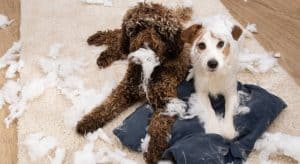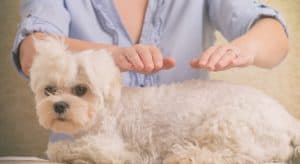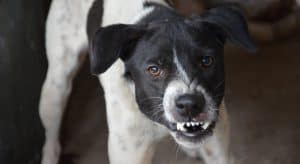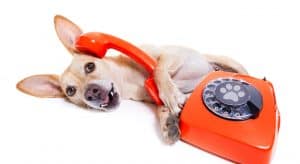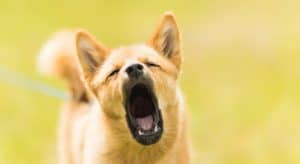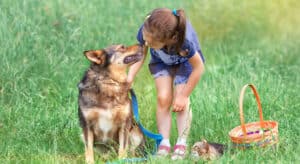House training a puppy without a crate or training pads is all about establishing a routine for the puppy and constant supervision of the pup during this training. New puppies bring so much happiness and joy to a household, however, they also require a lot of work and when it comes to house training a puppy you will need plenty of patience and commitment.
How Long Will House Training a Puppy Take?
Some puppies learn house training in a matter of days but this is the exception to the rule. On average most puppies will take 3-6 months and some can take a year or more. Hopefully, you have one of the quick learners. If not then it’s good to have plenty of patience as it will be tested.
Puppies don’t have great control over their bladders and in general, they have control for one hour for every month of age. So a 3-month-old puppy could hold it for 3 hours.
Establish A Routine
The first step in house training a puppy is establishing a routine. Puppies are like babies. Any newborn parent will tell you that babies thrive on routine and it’s no different for puppies. From the time this new puppy crosses your dog, you should have an established routine plan laid out for his arrival.
1. Frequent Toilet Breaks
As puppies don’t have great control over their bladders they will need to be taken outside in order to avoid accidents inside the house. As soon as your puppy wakes from sleep you will need to take him outside. The same applies after a bout of playing or after eating or drinking.
2. Pick A Spot & Be Patient
When you take your puppy outside to relieve himself make sure you go to the same spot each time. Your puppy will learn that this is the spot where I do my business. When you take your puppy outside make sure you place a leash on him. Do not engage in chats and get him excited. Instead, just walk calmly to the spot and use your buzzword for peeing or poops.
As soon as the puppy relieves himself bring him back inside immediately. You need to teach him that this trip outside was to do his business and nothing else. If you start to play with your puppy outside after he relieves himself then this is sending him mixed messages. He won’t associate this trip outside as a toilet break.
3. Praise & Reward
Dogs just loved to be praised to tell them how great they are. This praise makes them happy. As soon as your puppy relieves himself in the designated outside spot then he should be lavished in praise. Make a fuss and tell him how wonderful he is and even a treat would not go amiss. However, always make sure he has completely finished before praising him as otherwise there could be excitement urine dribbles flying everywhere. Not the most pleasant thing to come flying through the air.
4. Regular Feeding Times
It’s important to have a regimented feeding schedule at set times every day and that includes the weekends. Make sure you feed your puppy at the same times each day. Most puppies are fed 3 to 4 times every day so make sure you stick to these times. It will definitely help as if you feed at scheduled times then there will be popping and peeing at certain times too.
5. Remove Water at Night
When your puppy is learning the ropes of house training you have to make things easier for him. It may sound cruel but you should remove the water at least 2 hours before your puppy settles down for the night. It will reduce the likelihood of accidents during the night. After that time if you feel your dog must have hydration, we suggest letting them lick on an ice cube.
On average most puppies will sleep 7/8 hours at night. If your puppy does wake during the night for a toilet break then you should make as little fuss as possible. Do not engage in talk or play and keep the lights down low. Bring him outside to his designated spot. When finished back inside and again no chatting and straight to his bed.
Heed the Signals
You will need to pay attention to your dog’s body language and his method of communicating. On most occasions, dogs will give off tell-tale signals that they need to urinate or defecate and it’s up to you to pick up on these signs. You have to learn on the job. So as soon as you see any of the signs below grab the leash and bring your puppy outside.
Some of the most common signs that dogs need a toilet break:
- Dog walking in circles is a classic sign that your dog wants to go to the toilet
- Scratching at the door.
- Uneasy and unsettled.
- Barking for no apparent reason (apart from his urge to pee).
If your dog does not give you a clue that he needs to relieve himself, you can teach him to ‘ ring a bell’. Check out our Advice Center – Dear Labby for a description of this.
Important to Supervise During House Training
When you are house training a young puppy you will have to be on supervision duty at all times. The puppy will always have to be in sight as otherwise out of sight means that there could be some sneaky toilet breaks happening without your knowledge. This can set the whole task of toilet training back.
If you cannot watch the puppy all the time then it might be best to confine him to a certain part of the house where he won’t be able to eliminate. This space should be just big enough that he can stand, turn around and lie down. You could use a section of the bathroom or kitchen and use baby gates to confine him to this place until you can provide full supervision again.
Accidents Can Happen
While house training your puppy he will most likely have some accidents and this is totally normal and acceptable. If you catch the puppy in the act you should do the following:
Disrupt him as soon as possible. If the puppy is in full flow make a sound to stop him. Either clap your hands or say “No” in a firm voice. You then quickly need to grab the leash and bring the puppy outside. Once he finishes make sure to heap lots of praise on him.
If you find a soiled spot in the house there is no point punishing your puppy as he would have no idea what’s going on. It’s only when you catch them in the act that they will understand. In the past, there was some awful advice to rub your dog’s nose in his poop. This type of behavior would make the situation much worse and the puppy will become scared and frightened and not understand why that occurred.
A soiled area needs to be completely cleaned and all traces of the urine or poop removed. Otherwise, your puppy will go back to that very same spot and eliminate there again.
The Ultimate House Training Guide
You should check out a comprehensive guide called The Ultimate House Training Guide. It is a complete resource to ensure your house training experience is positive and free of any problems from day one. It has illustrations diagrams and easy-to-follow guides in each chapter and it takes you through the entire process step by step.


